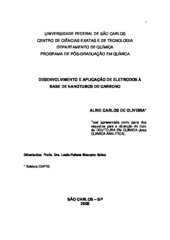Desenvolvimento e aplicação de eletrodos à base de nanotubos de carbono
Abstract
The electrodes based on carbon nanotubes (CNTs) were
prepared in the form of paste of CNTs/Graphite and film on glassy carbon electrode. These electrodes were electrochemically characterized by their response in potassium ferricyanide and hydroquinone. Considering the obtained results, the electrode in the form of paste was selected for analytical applications. In this work, the paste electrode was also prepared of pure CNTs, ie, without addicting of graphite. For the evaluation of analytical capabilities of the CNTs paste electrode, studies were performed about quantification of paraquat, rutin and quercetin, using differential pulse voltammetry. Regarding the quantification of paraquat, an analytical curve was obtained, with a detection limit of 2.8 x10-6mol L-1. The performance of the carbon nanotubes paste electrode in the determination
of rutin, an analytical curve was obtained, with a detection limit of 3.39 x10-8 mol L-1. The content of rutin was determined in pharmaceutical formulations with relative
error lower to 5%. For the quantification of quercetin, an analytical curve was obtained with a detection limit of 5.43 x10-7 mol L-1. Chemical modifiers, such as copper microparticles and acetylcholinesterase enzyme, were incorpored in the CNTs paste electrode. The CNTs paste electrode odified with copper microparticles (Cu-CNTs) was used for quercetin determination and the results indicated the formation of quercetin-Cu (II) complex on the electrode surface. The analytical curve obtained for this system presented a detection limit of 2.36 x10-7 mol L-1. The determination of quercetin in a sample of industrialized apple juice was carried out observing the recovery between 98.8 and 102.9%. The biosensor CNTs-AchE was optimized with respect to the work potential, concentration of acetylthiocoline iodide substrate and the incubation time and analytical curve was obtained for chlorfenvinphos with a detection limit of 1.15 x10-7 mol L-1. Even with respect to chlorfenvinphos, its determination was possible in samples containing the pesticide, with relative error lower to 2.5%.
